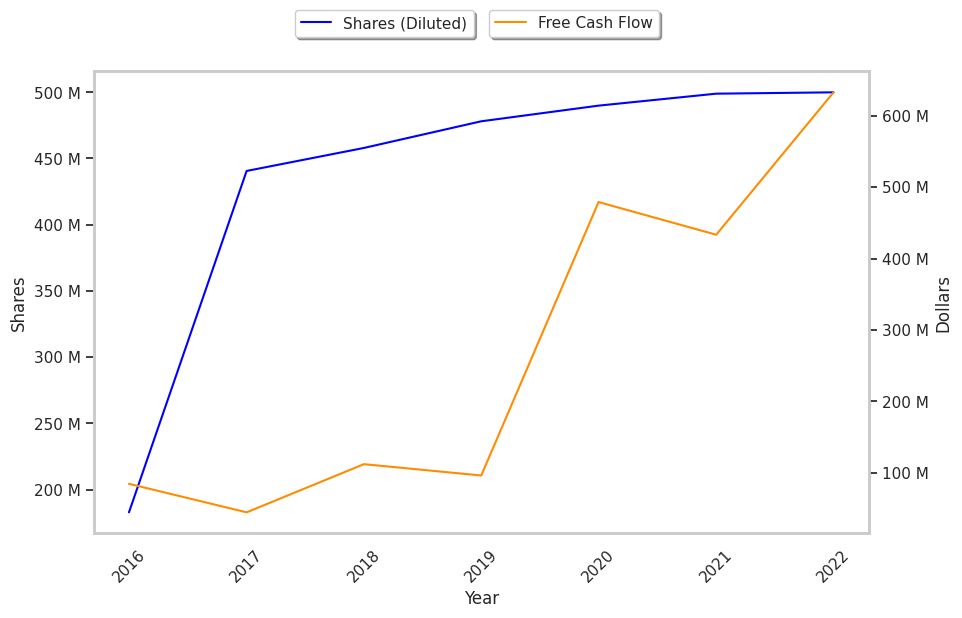One of the biggest losers as of today's evening session is software company The Trade Desk, whose shares are down -5.0%, underperforming the Nasdaq by -4.0%.
At $80.24, TTD is 9.16% below its average analyst target price of $88.33.
The average analyst rating for the stock is buy. TTD underperformed the S&P 500 by -5.0% so far today, but outpaced the index by 37.0% over the last year with a return of 59.0%.
The Trade Desk's trailing 12 month P/E ratio is 308.6, based on its trailing EPS of $0.26. The company has a forward P/E ratio of 53.9 according to its forward EPS of $1.49 -- which is an estimate of what its earnings will look like in the next quarter. As of the first quarter of 2023, the average Price to Earnings (P/E) ratio of US technology companies is 27.16, and the S&P 500 average is 15.97. The P/E ratio consists in the stock's share price divided by its earnings per share (EPS), representing how much investors are willing to spend for each dollar of the company's earnings. Earnings are the company's revenues minus the cost of goods sold, overhead, and taxes.
TTD’s price to earnings ratio can be divided by its projected five-year growth rate, to give us the price to earnings, or PEG ratio. This allows us to put its earnings valuation in the context of its growth expectations which is useful because companies with low P/E ratios often have low growth, which means they actually do not present an attractive value.
When we perform the calculation for The Trade Desk, we obtain a PEG ratio of 2.84, which indicates that the company is overvalued compared to its growth prospects. The weakness with PEG ratios is that they rely on expected growth estimates, which of course may not turn out as expected.
To better understand the strength of The Trade Desk's business, we can analyse its operating margins, which are its revenues minues its operating costs. Consistently strong margins backed by a positive trend can signal that a company is on track to deliver returns for its shareholders. Here's the operating margin statistics for the last four years:
| Date Reported | Total Revenue ($ k) | Operating Expenses ($ k) | Operating Margins (%) | YoY Growth (%) |
|---|---|---|---|---|
| 2023-02-15 | 1,577,795 | -1,183,018 | 7 | -30.0 |
| 2022-02-16 | 1,196,467 | -850,096 | 10 | -41.18 |
| 2021-02-19 | 836,033 | -513,013 | 17 | 0.0 |
| 2020-02-28 | 661,058 | -392,682 | 17 | -22.73 |
| 2019-02-22 | 477,294 | -255,873 | 22 | -4.35 |
| 2018-02-28 | 308,217 | -172,631 | 23 |
- Average operating margins: 16.0%
- Average operating margins growth rate: -17.6%
- Coefficient of variability (lower numbers indicate less volatility): 39.9%
Another key to assessing a company's health is to look at its free cash flow, which is calculated on the basis of its total cash flow from operating activities minus its capital expenditures. Capital expenditures are the costs of maintaining fixed assets such as land, buildings, and equipment. From The Trade Desk's last four annual reports, we are able to obtain the following rundown of its free cash flow:
| Date Reported | Cash Flow from Operations ($ k) | Capital expenditures ($ k) | Free Cash Flow ($ k) | YoY Growth (%) |
|---|---|---|---|---|
| 2023-02-15 | 548,734 | -84,160 | 632,894 | 46.06 |
| 2022-02-16 | 378,513 | -54,804 | 433,317 | -9.56 |
| 2021-02-19 | 405,069 | -74,061 | 479,130 | 399.62 |
| 2020-02-28 | 60,205 | -35,693 | 95,898 | -14.22 |
| 2019-02-22 | 86,603 | -25,191 | 111,794 | 152.43 |
| 2018-02-28 | 31,224 | -13,064 | 44,288 |
- Average free cash flow: $299.55 Million
- Average free cash flow growth rate: 0.0%
- Coefficient of variability (the lower the better): 257235338.8%
Free cash flows represents the amount of money that is available for reinvesting in the business, or paying out to investors in the form of a dividend. With a positive cash flow as of the last fiscal year, TTD is in a position to do either -- which can encourage more investors to place their capital in the company.
Another valuation metric for analyzing a stock is its Price to Book (P/B) Ratio, which consists in its share price divided by its book value per share. The book value refers to the present liquidation value of the company, as if it sold all of its assets and paid off all debts. As of the first quarter of 2023, the average P/B ratio for technology companies is 6.23. In contrast, the average P/B ratio of the S&P 500 is 2.95. The Trade Desk's P/B ratio indicates that the market value of the company exceeds its book value by a factor of 18, so it's likely that equity investors are over-valuing the company's assets.
As of first quarter of 2023, The Trade Desk is likely overvalued because it has an inflated P/E ratio, an elevated P/B ratio, and irregular cash flows with a flat trend. The stock has poor growth indicators because of its weak operating margins with a negative growth trend, and a negative PEG ratio. We hope this analysis will inspire you to do your own research into TTD's fundamental values -- especially their trends over time.



